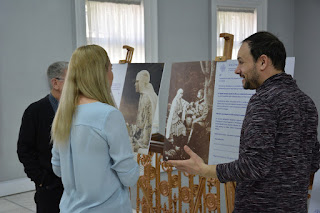 The exhibition of the project "Queen Maria, irresistible ambassador of Romanian history and folk art" is a cultural endeavor that aims to promote the beauty and richness of Romanian traditions and folk art, starting from the pride and passion with which Queen Maria promoted these cultural values authentic both through his political activity and through his cultural work.
The exhibition of the project "Queen Maria, irresistible ambassador of Romanian history and folk art" is a cultural endeavor that aims to promote the beauty and richness of Romanian traditions and folk art, starting from the pride and passion with which Queen Maria promoted these cultural values authentic both through his political activity and through his cultural work.
The exhibition speech made by the historian Nicolae Pepene is focused on archival images of the Crown Princess / Queen Maria of Romania in folk costume, photographed in her residences in Bicaz, Bran, Cotroceni or Peleș. Images from the period 1893 - 1936 are presented, accompanied by explanatory texts and quotes from the work of the sovereign. The exhibition also includes a selection of images from the illustration of children's books written by Queen Maria, works that abound in drawings inspired by the image of traditional Romanian costumes and objects adorned with popular motifs.
The exhibition "Queen Maria, irresistible ambassador of Romanian history and folk art" was launched in 2018, on the occasion of the celebration of the Centenary of Great Romania, being presented at the Cotroceni National Museum and, in outdoor form, in Piața Unirii in Oradea, in Piața Unirii from Râșnov, Piața Sfatului from Brașov and at the Bran National Museum. Then, the exhibition was presented in Iași, in the pedestrian area of Ștefan cel Mare și Sfânt Boulevard, and in Timișoara, in Iulius Mall, in 2019, and at the Maramureș County Museum of Ethnography and Folk Art, in 2020.
At the international level, the exhibition "Queen Maria, irresistible ambassador of Romanian history and folk art" was presented in Washington DC, at the United States Institute of Peace, within the Alliance Gala Awards 2018; in Brussels, in the main headquarters of the EU Council and the General Secretariat of the Council of Europe (Justus Lipsius building), on the occasion of the "Open Day" event at the European institutions in Brussels, in 2019; in Paris, in the headquarters of the Romanian Embassy in France, as part of the "For the love of beauty" Festival, organized by the Romanian Orthodox Metropolitanate of Western and Southern Europe, on October 13, 2019 (the event was attended by HRH Margareta, the Custodian of the Crown of Romania, and the Prince Radu of Romania).
The exhibition also traveled to Ireland, Dublin, Canada, Montreal and Quebec in 2018; in the United States of America, in Philadelphia, Chicago and St. Paul (Minnesota) in 2019 and at the Maryhill Museum of Art in 2020.
The exhibition "Queen Maria, irresistible ambassador of Romanian history and folk art" is made by the Brașov County Museum of History, together with the Forums Association, and is traveling in the Republic of Moldova with the support of the National Museum of History of Moldova, the Bessarabian Youth Association and Brasov County Council. The presentation in Chisinau of the exhibition dedicated to the Queen of Great Romania is the occasion of the celebration of 105 years since the Union of Bessarabia with Romania in 1918, being a cultural activity initiated by the Bessarabian Youth Association.
The exhibition "Queen Maria, irresistible ambassador of Romanian history and folk art" can be visited between March 23 and April 30, 2023, in the hall on the ground floor of the National Museum of History of Moldova, 31 August 1989 street, 121A.


























































